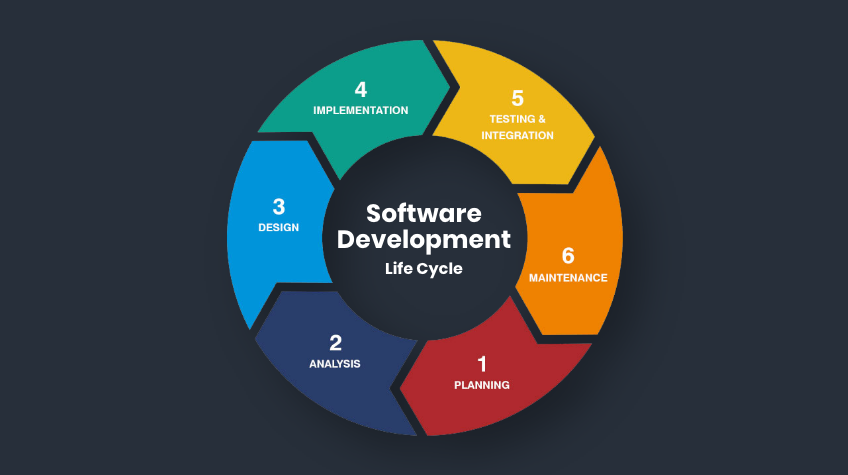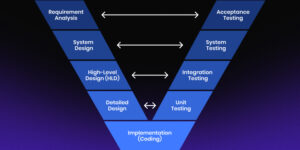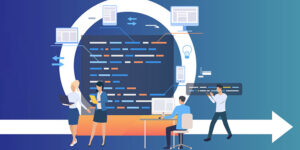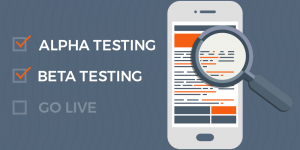
Software Development Life Cycle (SDLC) is a stage-based planning and execution process in which different individuals, groups, or hierarchies participate. This cycle manages the software development process from start to finish. The SDLC methodology consists of 5 phases: necessities identification, research, strategy, execution, and verification.
In many organizations, there needs to be more clarity about the software development life cycle. This guide addresses this confusion by explaining the specific phases of software development: start-up, incubation, growth, and maturity.
The software development life cycle (SDLC) is a model describing the process by which an application is designed, developed, tested, and maintained. It uses the acronym SDLC to reference this process in general.
Why Do We Require A Software Development Process Cycle?
A Software Product Development Life Cycle needs to clearly define the phases in the process and ensure that the development activities are well-organized. The phases or milestones that make up a Software Development Life Cycle include Requirements Documents, User Interface Design Documents, Design Documentation, Software Design Documents, Prototype Development, and Validation Testing.
Software Development Life Cycle (SDLC) is a process of creating, documenting, and testing computer programs. As the name suggests, it involves activities to determine requirements and develop the software. The software development life cycle (SDLC) is a software engineering process that includes evaluating the need for the product, designing it, and testing it.
The stepwise development of an extensive software program is called the software life cycle. Its main objective is to create a scalable and repeatable platform with optimized business processes and quality assurance.
What are the phases of the software development life cycle?
1) Requirement gathering and research
Requirements gathering and analysis is the first phase of the software development cycle. During this phase, you collect information to understand what needs to be done. You ask questions, speak with people, and define problems. The requirement gathering and analysis phase includes establishing the industry, consumer, and specialized needs.
These are the input to the planning stage. Before starting a project, people imagine what it might look like. This is usually done through brainstorming and idea generation. These are the steps required to gather and analyze requirements from stakeholders. As the project team creates conditions and analyses of existing information to determine the feasibility of a project and the priority of each phase, they decide upon the flow and stages of that process.
2) Design
The design phase involves defining requirements and creating a conceptual plan for the project. The design phase is where the software developers brainstorm and explain what they hope to develop. After this phase, they often create a detailed specification of the product so it can be designed and produced. The design phase is the foundation for building your software. It’s where you create a vision and sketch out ideas for how to make your product better.
You’ll identify what problems will be solved and the goals of your product set out the requirements, and define how each feature or task should work. The design phase of the software development life cycle is the most expensive because it includes the creation of a complete specification and user interface definition, but it’s necessary for a compelling product that meets or exceeds customer needs.
3) Implementation and Coding
Implementing the code is one of the software development life cycle’s most critical and vital stages. In this phase, the developers implement the requirements of the program or service. They work with quality assurance engineers and test managers to produce working systems that meet all functional requirements according to plan. The implementation phase is when the programmers put their code into action by building the program.
This can also be divided into three stages planning, creating, and executing. In planning, the developers need to decide how they will build their program once they’re done with coding. The creation stage describes how their code will look and function visually so that users can understand what to do with it. During this process, developers also pay attention to any testing or debugging procedures necessary to ensure everything looks right before deployment. Finally, the execution stage is also referred to as programming.
It involves writing code to meet the requirements of a system and conforms to standard practices. This is where all of your project tasks logically fall under a process. You should allocate sufficient resources, such as time and budget, to complete this phase so that other team members can continue working on their respective tasks without stepping on each other’s toes.
4) Testing
Testing is the stage in which the software is designed. This phase includes integrating, building, and delivering the final product. At this stage, bugs and any other issues that may have arisen during a particular development stage are detected and fixed. After new software is developed, testing needs to be done. The testing phase includes unit testing, integration testing and system testing.
The testing phase consists of the development of two types of tests: Unit testing, where individual components of the software are tested together (e.g., to ensure that the logic is working correctly), and functional testing, which tests a broader range of features of the software against its declared requirements. Tests are grouped into one or more groups by type and targeted at specific functions.
5) Deployment
Deployment is the phase in which the software product is transferred from a development environment to an operational environment for testing and, ultimately, for use. Deployment is the software development life cycle phase where software goes fully functional on a trial basis. After that, the software needs to be deployed on different platforms for practical use.
Deployment can be a sizeable complex procedure involving building, testing, and releasing new code in the production environment. The deployment phase is when the software is officially deployed to its final destination. The deployment process consists of putting a copy of the software on one or more systems (which might include testing systems). Once deployed, you can start collecting data about how well it’s working.
6) Maintenance
Maintenance is the stage of software development in which the source code is modified to fix, remediate or modify a bug or to add features that were not originally planned. Maintenance refers to non-updates and software maintenance. Maintenance activities include enhancements, bug fixes, and security patches that are not intended as a new software release.
The maintenance phase is the second step in the life cycle, after the development and testing of a product. It involves reviewing applications, and making changes and enhancements to maintain, support, and improve the product. The maintenance phase of software development goes hand-in-hand with the formal test phase. For example, you can add features and fix bugs as a software engineer. To do this properly, your code will need to be in good shape: it should have been thoroughly tested before release, and documentation should be available for how to use the new functionality.
Also See: What is DevOps and How It Works: Ultimate Overview and Guide
Benefits of Software Development Life Cycle
The Software Development Life Cycle has many benefits: it allows for better communication between developers, managers, and associates. It also enables quicker development of new code, which reduces the cost of testing and eliminates bugs at the end of each development cycle. It also helps organizations become more efficient by ensuring they are always on the cutting edge of software engineering trends.
Software Development Life Cycle provides a framework for planning, managing, and monitoring projects from requirements through development and maintenance. Software Development Life Cycle is an important project management tool that influences the overall software development cost and helps the business to focus on its objectives rather than project management practices.
The software development life cycle encompasses developing new IT products and services. It’s a methodical way to develop, test, deliver and use software services. The software life cycle is a conceptual model that describes how organizations employ software engineering to create, test and deploy their business applications. It is a structured set of activities teams perform to generate value from a specific stage in the lifecycle. Software development can take many forms, such as adding new features to an existing product or creating an entirely new function.
CONS OF Software Development Life Cycle
Adopting a new process in the software development life cycle is complex. The main goal of the process is to deliver a finished product within the agreed budget but to do that, you need to identify all the issues and risks. It will require a lot of time and effort, so starting with small projects and working your way up gradually is essential.
The Software Development Life Cycle is a process that helps you to understand how your software will be created, tested, and build. It contains four phases: conceptual, design, implementation, and test.
The software development life cycle is a sequence of tasks that must be accomplished from conception to completion.
The life cycle must follow a particular order in the development procedure so that the finished outcome satisfies predetermined specifications and necessities. The software development life cycle is an iterative process where various groups of people participate from early formulation to design and to code, to testing and deployment.
MODELS OF Software Development Life Cycle
Below we have mentioned some models or approaches that use SDCL phases to develop a product.
1. Waterfall model
The waterfall model is where data and software are developed in successive stages. The waterfall model is where data and software are produced in subsequent steps. The waterfall model is a software development life cycle that provides the most comprehensive view of an organization’s requirements and needs. It follows a logical sequence of steps from initiation to delivery and covers both plannings for development and post-development testing of products.
The waterfall model is a sequential, planned approach to software development in which the entire project, from start to finish, is defined and managed in advance. The waterfall model is a software development life cycle (SDLC) technique in which a structured, sequential process is applied to the overall development of software and then tested, modified, and re-tested.
2. Spiral model
A spiral model is an incremental approach for software life cycle management. It attempts to represent the process of setting up a new project and is used extensively by large companies. The spiral model describes a series of activities that occur in a project, from initial planning and requirements gathering to design and coding, through testing, and finally, deployment.
This software development life cycle model describes the processes during software solution development. It’s often known as the spiral model or the Capability Maturity Model and is used to show how to break a system down into smaller components and then add new capabilities piece by piece until you arrive at a functional product, including feature integration and test execution.
The software development life cycle spiral model is helpful if you want to understand the entire process. It encompasses the five phases—idea, design, code, test, and release. In addition, the spiral software development model suggests that the product incrementally transforms from a vision statement into an executable working system.
3. Iterative model
The iterative model describes the life cycle of a software project from its requirements to design and development, testing, deployment, and maintenance of the software. The iterative model of the software development life cycle goes through the following stages: discovery and definition phase, requirements gathering and design phase, development phase, and deployment phase. The iterative model allows for a software product’s continuous improvement and refinement.
Developed by Thomas Henry Morf, the iterative model is commonly used by agile methodologists to plan projects. Iteration is improving a product based on previous work to reach the desired outcome. The main driving force behind iteration is that there is often no optimal solution, and breaking from one outcome to another will always positively affect your project. As a result, the iterative model is the most popular model for software development.
This cycle has two phases: Planning and Development. The planning phase defines the project’s purpose, estimates development costs, develops a plan for appointing work, and schedules milestones. During this phase, all aspects of product planning, such as requirements analysis and design blueprints, are performed using iterative processes such as brainstorming, storyboarding, and prototyping.
4. Agile model
The agile software development life cycle (SDLC) is a model that compiles many techniques, practices, and methodologies into a comprehensive method that focuses on the customer’s needs rather than the process and time.
The Agile Manifesto introduced the agile model of software development, and its popularity increased in the 2000s. It aims to increase efficiency, improve communications, and minimize risk in creating software over a short period. The Agile Model is a software development life cycle that provides fast, flexible, and reliable solutions to problems through a bottom-up approach. Agile aims to improve the productivity and efficiency of development teams by breaking down complex problems into manageable chunks, with developers working concurrently on multiple elements during each iteration.
The agile model is a software development life cycle that emphasizes communication, collaboration, and adaptation. The intent is to accelerate and improve the quality of products. Some say it’s easier to change according to what you hear than you speak.
FAQs
What is the most crucial stage of the software development life cycle?
The testing stage is the most crucial in the software development life cycle because its impossible to provide quality software without testing.
What is the SDLC life cycle?
The software development life cycle is a systematic approach that enables the production of elevated quality, cost-effective software in the fastest possible development time.
Which tools are used for SDCL?
The most popular SDCL model is Agile SDCL, usually paired with a proven project managing procedure. Bitbucket, Bamboo, Git, Jira, Confluence, and Sourcetree are the most prevalent software tools of current times.
Why is SDCL important?
SDCL provides a valuable framework and method for developing software applications. In addition, SDCL helps in planning before beginning the actual development. It allows the developers to explore the necessities and helps reduce high costs during development costs.
Which tool is popular in Agile?
Jira Software is one of the most popular projects and issue-tracking tools. It’s beneficial for bug tracking, user stories, and epics. However, this agile development and management tool is used mainly by development teams and only sometimes by other business divisions.
Can we ignore a step in SDCL?
SDCL can be cracked down into five to seven steps. It does not matter how many steps you use, but you must carry them out in order; you can’t ignore a step.
CONCLUSION
The software development life cycle has many variations, but all versions aim to deliver the highest quality product at the most affordable cost. The phrase goes, “If you adore someone, set them free. But it was indicated to be if it comes around to you.” And if you listen to your heart and live by your passion every day, then this might be a life-long relationship!
The Software development life cycle is a valuable framework for analyzing how software developments are made. Building something from start to finish can be daunting, yet it’s an essential part of our lives, economies, and societies. Furthermore, the valuable lessons learned from various stages of development can be applied in any organization regardless of size or industry. Therefore, you must implement a new software life cycle process with which you are entirely confident.






